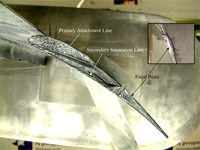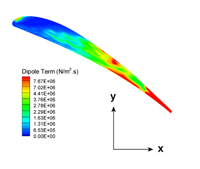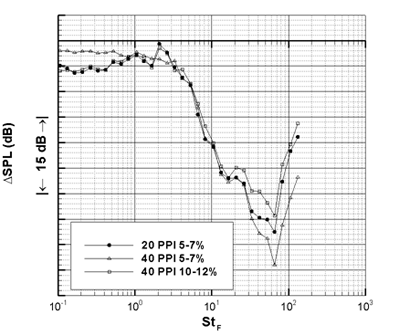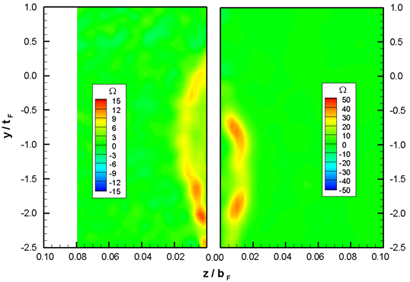An experimental and computational investigation was carried out to determine the aerodynamics and aeroacoustics of a flap side-edge. A porous side-edge treatment was applied to the flap side-edge in an attempt to reduce airframe noise. The application of a porous flap side-edge had two favourable effects. Firstly, it reduced the magnitude of vorticity in the turbulent shear layer and the vortex. This reduced the magnitude of the hydrodynamic instabilities induced by the flap side-edge vortex. Secondly, it displaced the vortex further away from the flap surface due to the finite mass flux allowed through the porous material. This reduced the magnitude of the disturbances that interacted with the solid flap surface by moving them further away.

Figure 1: Model in R.J. Mitchell wind tunnel
An experimental and computational investigation was carried out to determine the aerodynamics and aeroacoustics of a flap side-edge. A porous side-edge treatment was applied to the flap side-edge in an attempt to reduce airframe noise. The application of a porous flap side-edge had two favourable effects. Firstly, it reduced the magnitude of vorticity in the turbulent shear layer and the vortex. This reduced the magnitude of the hydrodynamic instabilities induced by the flap side-edge vortex. Secondly, it displaced the vortex further away from the flap surface due to the finite mass flux allowed through the porous material. This reduced the magnitude of the disturbances that interacted with the solid flap surface by moving them further away.
This research was focused on understanding noise generation mechanisms associated with the flowfield around a flap-side edge and their reduction. Previous investigations identified a noise reduction of up to 4 dB in the far-field, within a limited band of frequencies, by replacing part of a flap side-edge with an open cell porous material. The physics responsible for this were not discussed. This work employed a variety of experimental and numerical techniques to understand the physics responsible for noise production at the flap side-edge and the mechanism by which a porous material applied to the flap side-edge reduced the noise.

Figure 2: On-surface flow features

Figure 3: FWH dipole source strength
The experiments were conducted in the University of Southampton 3.5m × 2.5m wind tunnel. The computational fluid dynamic investigation performed was a detached eddy-simulation of the half-span flap configuration with a grid size of 4.7 x 106.
Shown in figure below are the on-surface flow features as determined by oil flow surface visualisation and the strength of the dipole source term as determined by an FW-H solution. The peak pressure perturbations were generated along the primary attachment line and aft of the focal point where the vortex separated from the flap surface.
The effect of applying a porous flap side-edge was to reduce the strength of the turbulent shear layer that was wrapped around the vortex. This was due to the easing of the pressure difference between the suction and the pressure surfaces. The second effect was a displacement of the flap side-edge vortex vertically away from the flap surface. The vertical displacement of the edge of the vortex away from the flap surface was approximately one flap thickness at the PIV plane shown in the figure below. The application of a porous side-edge reduced the near-field pressure perturbations as measured by on-surface microphones. The major reductions in the near-field sound pressure levels were from 2 kHz to 12.5 kHz.

Figure 4: Change in nearfield SPL

Figure 5: PIV with porous and hard side-edge
The application of a porous flap side-edge reduced the strength of the vortex and displaced it away from the flap surface. This reduced its efficiency as an acoustic source. The unsteady pressure fluctuations are the flap surface were shown to be reduced with the application of the porous side-edge.